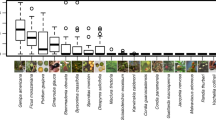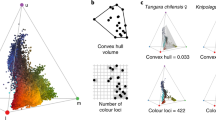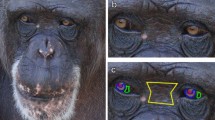Abstract
Trichromatic colour vision, characterized by three retinal photopigments tuned to peak wavelengths of ∼430 nm, ∼535 nm and ∼562 nm (refs 1, 2), has evolved convergently in catarrhine primates and one genus of New World monkey, the howlers (genus Alouatta)3. This uniform capacity to discriminate red–green colours, which is not found in other mammals, has been proposed as advantageous for the long-range detection of either ripe fruits4,5 or young leaves6 (which frequently flush red in the tropics7) against a background of mature foliage8,9. Here we show that four trichromatic primate species in Kibale Forest, Uganda, eat leaves that are colour discriminated only by red–greenness, a colour axis correlated with high protein levels and low toughness. Despite their divergent digestive systems, these primates have no significant interspecific differences in leaf colour selection. In contrast, eaten fruits were generally discriminated from mature leaves on both red–green and yellow–blue channels and also by their luminance, with a significant difference between chimpanzees and monkeys in fruit colour choice. Our results implicate leaf consumption, a critical food resource when fruit is scarce10, as having unique value in maintaining trichromacy in catarrhines.
This is a preview of subscription content, access via your institution
Access options
Subscribe to this journal
Receive 51 print issues and online access
$199.00 per year
only $3.90 per issue
Buy this article
- Purchase on Springer Link
- Instant access to full article PDF
Prices may be subject to local taxes which are calculated during checkout



Similar content being viewed by others
References
Li, W.-H., Tan, Y., Boissinot, S., Shyue, S. K. & Hewett-Emmett, D. in The Biology of Biodiversity (ed. Kato, M.) 259–274 (Springer, Tokyo, 2000).
Jacobs, G. H. & Deegan, J. F. II Uniformity of color vision in Old World monkeys. Proc. R. Soc. Lond. B 266, 2023–2028 (1999).
Kainz, P. M., Neitz, J. & Neitz, M. Recent evolution of trichromacy in a New World monkey. Vis. Res. 38, 3315–3320 (1998).
Allen, G. The Colour Sense: Its Origin and Development (Trübner, London, 1879).
Regan, B. C. et al. Frugivory and color vision in Alouatta seniculus, a trichromatic platyrrhine monkey. Vis. Res. 38, 3321–3327 (1998).
Lucas, P. W., Darvell, B. W., Lee, P. K. D., Yuen, T. D. B. & Choong, M. F. Colour cues for leaf food selection by long-tailed macaques (Macaca fascicularis) with a new suggestion for the evolution of trichromatic colour vision. Folia Primatol. 69, 139–152 (1998).
Coley, P. D. & Kursar, T. A. in Tropical Forest Plant Ecophysiology (eds Mulkey, S. S., Chazdon, R. L. & Smith, A. P.) 305–336 (Chapman & Hall, New York, 1996).
Sumner, P. & Mollon, J. D. Catarrhine photopigments are optimized for detecting targets against a foliage background. J. Exp. Biol. 203, 1963–1986 (2000).
Sumner, P. & Mollon, J. D. Chromaticity as a signal of ripeness in fruits taken by primates. J. Exp. Biol. 203, 1987–2000 (2000).
Terborgh, J. & van Schaik, C. P. in Organization of Communities Past and Present (eds Gee, J. H. R. & Giller, P. S.) 205–226 (Blackwell Scientific, Oxford, 1987).
Clutton-Brock, T. H. Primate Ecology (Academic, London, 1977).
Opler, P. A., Frankie, G. W. & Baker, H. G. Comparative phenological studies of treelet and shrub species in tropical wet and dry forests in the lowlands of Costa Rica. J. Ecol. 68, 167–188 (1980).
Juniper, B. E. in International Dendrological Society Yearbook 49–57 (International Dendrological Society, London, 1993).
Lucas, P. W., Turner, I. M., Dominy, N. J. & Yamashita, N. Mechanical defences to herbivory. Ann. Bot. 86, 913–920 (2000).
Chapman, C. A. & Janson, C. H. in Primate Communities (eds Fleagle, J. G., Janson, C. & Reed, K. E.) 237–267 (Cambridge Univ. Press, Cambridge, 1999).
Coley, P. D. Herbivory and defensive characteristics of tree species in a lowland tropical forest. Ecol. Monogr. 53, 209–233 (1983).
Korine, C., Kalko, E. K. V. & Herre, E. A. Fruit characteristics and factors affecting fruit removal in a Panamanian community of strangler figs. Oecologia 123, 560–568 (2000).
Fischer, K. E. & Chapman, C. A. Frugivores and fruit syndromes: differences in patterns at the genus and species level. Oikos 66, 472–482 (1993).
Terborgh, J. Five New World Primates (Princeton Univ. Press, Princeton, 1983).
Leighton, M. Modeling dietary selectivity by Bornean orangutans: evidence for integration of multiple criteria in fruit selection. Int. J. Primatol. 14, 257–313 (1993).
Gautier-Hion, A. et al. Fruit characters as a basis of fruit choice and seed dispersal in a tropical forest vertebrate community. Oecologia 65, 324–337 (1985).
Davies, A. G. & Oates, J. F. in Colobine Monkeys (eds Davies, A. G. & Oates, J. F.) 229–249 (Cambridge Univ. Press, Cambridge, 1994).
Wrangham, R. W., Conklin-Brittain, N. L., & Hunt, K. D. Dietary responses of chimpanzees and cercopithecines to seasonal variation in fruit abundance: I. antifeedants. Int. J. Primatol. 19, 949–970 (1998).
Onishi, A. et al. Dichromatism in macaque monkeys. Nature 402, 139–140 (1999).
Struhsaker, T. T. Ecology of an African Rainforest (Univ. Florida Press, Gainesville, 1997).
Lucas, P. W. et al. Fieldkit to characterize the physical, chemical, and spatial aspects of potential primate foods. Folia Primatol. 72, 11–25 (2001).
Osorio, D. & Vorobyev, M. Colour vision as an adaptation to frugivory in primates. Proc. R. Soc. Lond. B 263, 593–599 (1996).
Darvell, B. W., Lee, P. K. D., Yuen, T. D. B., Lucas, P. W. Meas. Sci. Technol. 7, 954–962 (1996).
Newton-Fisher, N. E. The diet of chimpanzees in the Budongo Forest Reserve, Uganda. Afr. J. Ecol. 37, 344–354 (1999).
Gartlan, J. S., McKey, D. B., Waterman, P. G., Mbi, C. N. & Strusaker, T. T. A comparative study of the phytochemistry of two African rainforests. Biochem. Syst. Ecol. 8, 401–422 (1980).
Acknowledgements
We thank D. Osorio for help with colour registration; E. Ting, P. Y. Cheng, I. C. Bruce, R. T. Corlett, L. Ramsden, N. Yamashita and A. Walker for comments, P. Kagoro, B. Balyeganira and M. Musana for field assistance in Uganda; J. Magnay, R. W. Wrangham and C. A. Chapman for logistic support in Uganda; and the Ugandan National Council for Science and Technology, Ugandan Wildlife Authority and Makerere University Biological Field Station for permission to work at Kibale. Supported by Research Grants Council of Hong Kong, National Geographic Society, Sigma Xi, Explorer's Club and Croucher Foundation of Hong Kong.
Author information
Authors and Affiliations
Corresponding author
Rights and permissions
About this article
Cite this article
Dominy, N., Lucas, P. Ecological importance of trichromatic vision to primates. Nature 410, 363–366 (2001). https://doi.org/10.1038/35066567
Received:
Accepted:
Issue Date:
DOI: https://doi.org/10.1038/35066567
This article is cited by
-
How do sound and color features affect self-report emotional experience in response to film clips?
Current Psychology (2024)
-
The Contribution of Adaptive Optics to Our Understanding of the Mechanisms of Color Vision in Humans
Neuroscience and Behavioral Physiology (2023)
-
Bearing Fruit: Miocene Apes and Rosaceous Fruit Evolution
Biological Theory (2023)
-
Seeing with color: Psychophysics and the function of color vision
Synthese (2023)
-
What colour are your eyes? Teaching the genetics of eye colour & colour vision. Edridge Green Lecture RCOphth Annual Congress Glasgow May 2019
Eye (2022)
Comments
By submitting a comment you agree to abide by our Terms and Community Guidelines. If you find something abusive or that does not comply with our terms or guidelines please flag it as inappropriate.



